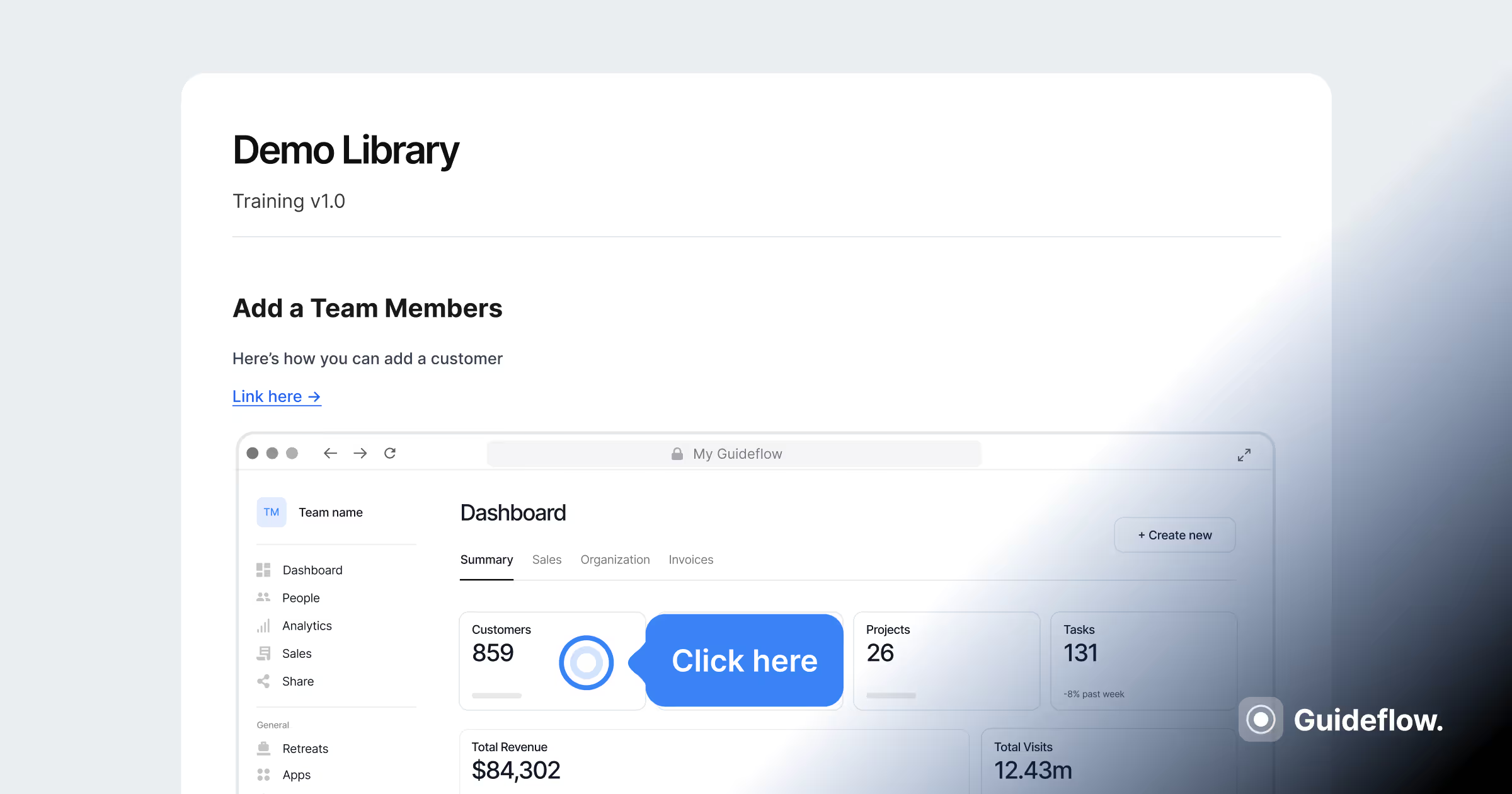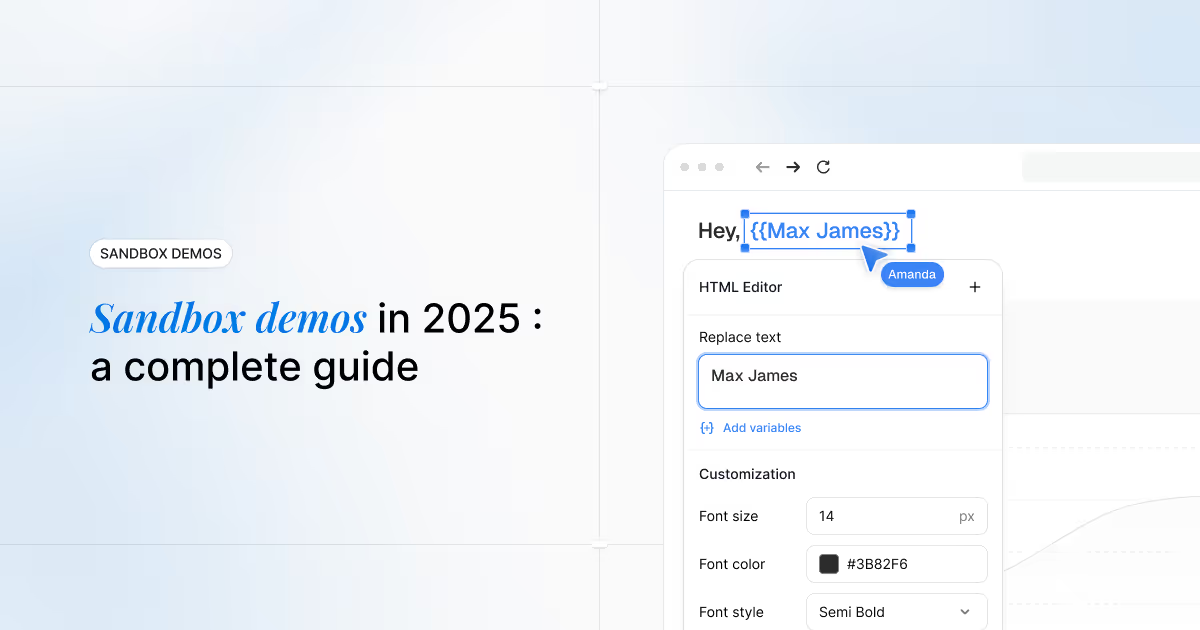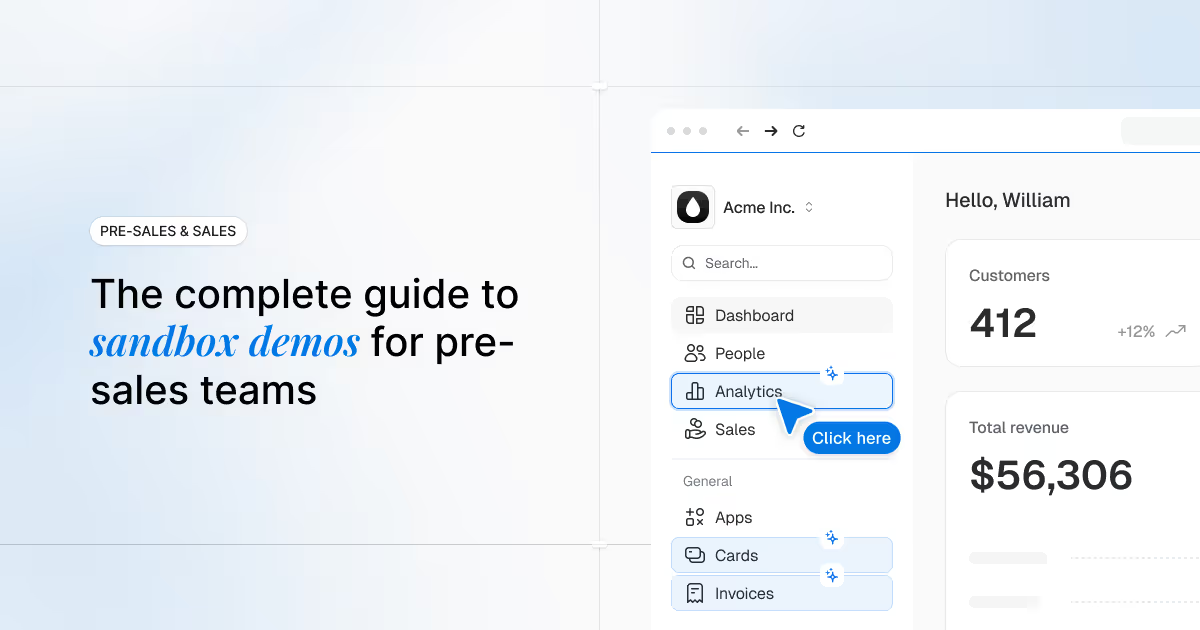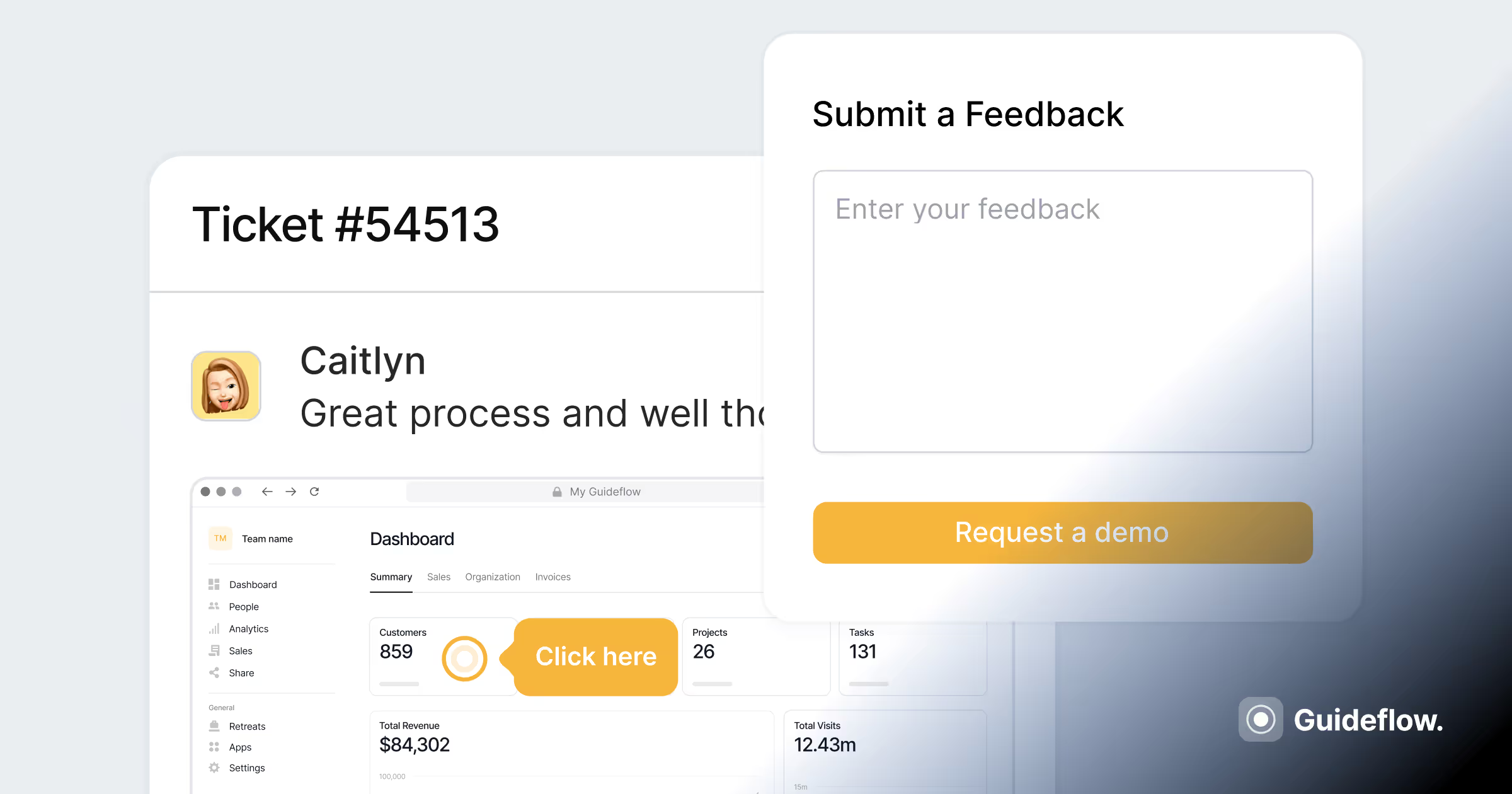What are live demos and why they're essential for sales teams



Sales teams face a critical trust problem in today's B2B landscape. Prospects have become increasingly skeptical of traditional product demonstrations that rely on static presentations, sanitized screenshots, and pre-scripted walkthroughs. They need authentic validation but struggle to gain confidence in product capabilities when demonstrations feel disconnected from real-world usage scenarios and performance characteristics.
This skepticism creates cascading problems that devastate sales performance. Prospects skeptical of static demos extend evaluation timelines while seeking authentic product validation. Inability to show real product behavior leaves technical evaluators unconvinced about post-purchase reality. Limited authentic exploration opportunities prevent prospects from testing edge cases and specific use scenarios that matter for their decision-making. Fake data disconnection from reality makes demonstrations feel artificial and irrelevant. Backend simulation gaps leave critical questions unanswered about integrations, performance, and actual user experience. These challenges create trust barriers that extend sales cycles, reduce conversion rates, and create competitive vulnerabilities when other vendors offer more authentic product experiences.
Live demos solve these authenticity problems by providing real-time product experiences that prospects can explore independently. Teams implementing live demos achieve 3.2x higher deal closure rates and 47% faster sales cycles through hands-on prospect validation and trust-building, while experiencing 65% increase in prospect engagement with real-time versus traditional demo approaches. From authentic prospect exploration and real-time discovery calls to hands-on evaluations and stakeholder walkthroughs, live demos provide genuine product environments with synthetic data that transform sales conversations from one-way presentations into collaborative product validation sessions that build trust and accelerate decision-making.
What are live demos?
Live demos are authentic product replications populated with synthetic data that let prospects experience full functionality in real-time interactive environments. They combine genuine user interfaces with realistic business scenarios while eliminating security risks and maintenance overhead through automated environment management and data refresh.
Unlike traditional demo approaches, live demos are:
- Functionally authentic with all product capabilities working exactly like production, including integrations and advanced features
- Data-realistic through synthetic content that mirrors genuine business scenarios and industry-specific workflows
- Automatically reset via instant environment refresh ensuring every prospect gets a clean, optimized experience
- Instantly accessible with no setup requirements, login complexity, or technical barriers for prospects
- Engagement-tracked with comprehensive analytics showing prospect behavior, feature interest, and qualification signals
- Always current through automated updates that keep demo environments synchronized with product releases
They serve sales teams across the entire prospect journey, from initial qualification and discovery calls to final stakeholder validation and proof-of-concept demonstrations, while providing embedded sales guidance and detailed buyer insights for enhanced deal progression.
Live demos vs. other demo approaches for sales teams
With 72% of prospects preferring authentic validation before purchase decisions, choosing the right demonstration strategy directly impacts your quota attainment and deal velocity. Here's how the three leading approaches perform for sales teams:
- Choose live demos when: You're selling complex enterprise software, managing multi-stakeholder deals, need to prove ROI through authentic scenarios, or want to accelerate technical evaluation phases while building prospect confidence.
- Choose sandboxes when: Prospects specifically request hands-on technical testing, you have straightforward workflows, and can accept limited scope in exchange for prospect control over exploration.
- Choose interactive demos when: You need consistent product education, have simple feature sets, focus on early-stage lead nurturing, or want to ensure every prospect receives identical messaging.
Bottom line for sales teams: Enterprise sales teams closing deals over $100K consistently choose live demos because authentic experiences with realistic data eliminate technical objections, accelerate stakeholder consensus, and provide the trust foundation needed for confident purchase decisions. Sandboxes support technical validation phases. Interactive demos excel for initial prospect education and marketing-qualified lead development.
The authentic product experience challenge
Sales teams encounter four critical barriers when trying to provide authentic product experiences through traditional demonstration approaches. Each barrier creates skepticism and extends sales cycles by preventing prospects from gaining genuine confidence in product capabilities.
Static demo limitations create the first major barrier. Artificial interactions dominate traditional presentations where prospects observe rather than participate. Fake workflows disconnect demonstrations from real business scenarios. Limited exploration prevents prospects from testing features relevant to their specific use cases. Backend disconnection means prospects cannot experience realistic data processing, integrations, or performance characteristics that matter for their technical evaluation.
Prospect skepticism intensifies when demonstrations feel unrealistic or oversimplified. Unrealistic scenarios using perfect data and ideal conditions fail to address real-world complexity prospects face daily. Sanitized experiences remove the authentic messiness and edge cases that prospects need to evaluate. Inability to test real use cases prevents prospects from validating how the product solves their specific problems. Trust barriers emerge when polished presentations feel disconnected from actual product reality, especially when prospects have experienced disappointing gaps between demonstrations and actual implementation.
Product complexity barriers prevent adequate evaluation of sophisticated B2B software solutions. Oversimplified demonstrations reduce complex products to surface-level feature tours that miss deeper functionality. Missing workflow context eliminates understanding of how features connect to create business value. Inability to show real integrations leaves technical evaluators uncertain about compatibility with existing systems. Feature depth limitations prevent prospects from understanding advanced capabilities that differentiate your solution from competitors.
Sales authenticity gaps create the final barrier between prospects and confident purchase decisions. Scripted interactions prevent natural exploration and discovery that builds genuine excitement. One-way presentations eliminate collaborative evaluation that engages multiple stakeholders. Limited prospect control reduces confidence in their ability to successfully adopt and implement the solution. Inability to simulate real environments leaves prospects uncertain about actual user experience and performance characteristics they'll encounter post-purchase.
How live demos accelerate sales performance
Live demos transform sales outcomes through eleven specific mechanisms that address core challenges preventing prospects from making confident purchase decisions.
- Build prospect trust through authentic product interactions in real-time environments where prospects experience actual software behavior rather than polished presentations. Trust develops when prospects can test edge cases, explore freely, and validate that product capabilities match sales claims.
- Enable hands-on product exploration with actual UI and realistic backend responses that demonstrate genuine product performance. Prospects gain confidence through direct interaction rather than passive observation, leading to stronger conviction about product value.
- Accelerate technical evaluations with genuine workflow simulations and integrations that technical evaluators can validate independently. Real-time testing eliminates concerns about post-purchase performance gaps and implementation challenges.
- Provide safe product testing without exposing live customer data or environments, enabling prospects to explore extensively without security concerns. Sales teams can offer unlimited access while maintaining data protection and system stability.
- Support real-time discovery calls with immediate feature demonstrations and customization that respond to prospect questions instantly. Sales conversations become more interactive and responsive to specific prospect needs and concerns.
- Allow prospect-driven exploration paths based on their specific use cases and needs, moving beyond scripted demonstrations to authentic product validation. Prospects can test scenarios most relevant to their decision-making process.
- Demonstrate actual product performance, speed, and user experience authentically, eliminating concerns about misleading presentations. Prospects experience real loading times, responsiveness, and interface behavior they'll encounter post-purchase.
- Enable stakeholder evaluations with role-specific, realistic product scenarios that address different user needs within the buying organization. Each stakeholder can validate product value from their perspective using relevant data and workflows.
- Capture genuine usage patterns and feature interest through real interaction data that provides insights unavailable through traditional demonstrations. Sales teams gain understanding of actual prospect priorities and concerns.
- Differentiate from competitors using static presentations or sanitized demo environments by offering superior product validation experiences. Live demos become competitive advantages when other vendors cannot provide authentic exploration opportunities.
- Reduce technical objections through hands-on validation of product capabilities, performance, and integration possibilities. Prospects address concerns through direct testing rather than relying on verbal assurances or documentation.
Real-time analytics insights and authentic user behavior tracking enhance sales conversations by providing data about prospect engagement, feature interest, and usage patterns. This information enables more targeted follow-up communications and addresses specific concerns identified through actual product interaction rather than assumptions about prospect needs.
Real-world sales team use cases
Use case 1: Authentic prospect exploration and qualification

Challenge
Sales teams struggle to qualify prospects effectively when traditional demos fail to reveal genuine product fit and authentic usage scenarios. Prospects often appear interested during presentations but lack genuine conviction about product value for their specific use cases. Static demonstrations prevent prospects from testing edge cases or exploring functionality relevant to their business processes, leading to false positives in qualification and extended sales cycles with unqualified opportunities.
Solution
Live demos enable authentic prospect exploration where potential buyers can test real workflows, explore features independently, and validate product fit through hands-on interaction. Prospects access realistic environments with synthetic data that mirrors their industry scenarios, allowing genuine evaluation of product capabilities. Sales teams observe prospect behavior during exploration sessions to identify authentic interest signals and qualification indicators based on actual usage patterns rather than verbal feedback alone.
Benefits
- 78% of prospects prefer hands-on product exploration before purchase decisions, leading to higher-quality qualification
- Immediate identification of product-market fit through authentic testing scenarios
- Reduced time spent on unqualified opportunities that lack genuine product need
- Enhanced prospect confidence through independent validation of product capabilities
When to use
- Early-stage prospect qualification when product fit remains uncertain
- Complex enterprise sales where multiple use cases require validation
- Technical evaluation phases requiring hands-on product assessment
- Competitive situations where authentic exploration provides differentiation
Use case 2: Real-time discovery calls and technical evaluations

Challenge
Discovery calls often rely on prospects describing their needs while sales teams present generic product capabilities, creating disconnection between actual requirements and demonstrated solutions. Technical evaluators need hands-on validation but traditional approaches limit their ability to test integration scenarios, performance characteristics, or advanced functionality. This gap extends technical evaluation phases and creates objections that could be resolved through direct product interaction.
Solution
Live demos transform discovery calls into collaborative exploration sessions where prospects demonstrate their requirements using actual product functionality. Technical evaluators can test integrations, validate performance, and explore advanced features in real-time while sales teams observe and guide the evaluation process. Real-time environment customization allows immediate adaptation to prospect scenarios and requirements discovered during conversations.
Benefits
- 54% improvement in technical evaluation success through authentic product testing
- Immediate resolution of technical objections through hands-on validation
- Enhanced discovery call quality through prospect-driven demonstration of needs
- Accelerated technical evaluation cycles with real-time requirement validation
When to use
- Technical discovery calls with IT evaluators and system administrators
- Complex integration scenarios requiring validation of compatibility
- Performance evaluation requirements needing authentic testing environments
- Advanced feature demonstrations for sophisticated user requirements
Use case 3: Hands-on stakeholder evaluations and validation
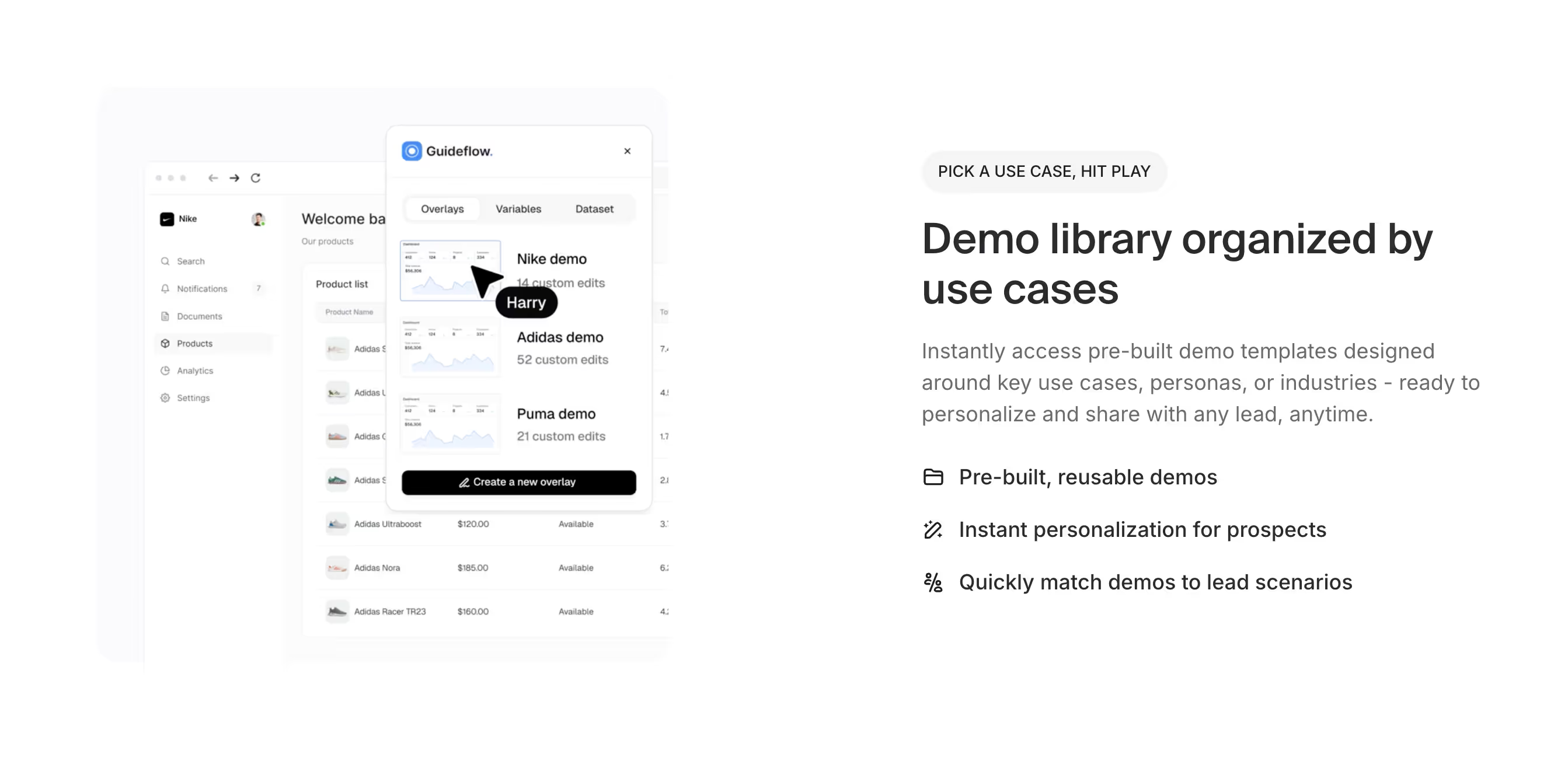
Challenge
B2B purchase decisions involve multiple stakeholders with different priorities, technical requirements, and evaluation criteria. Traditional demonstrations struggle to address diverse stakeholder needs effectively, often requiring multiple separate presentations that fail to provide authentic validation experiences. Stakeholders may approve conceptually but lack confidence in practical implementation and user adoption success.
Solution
Live demos provide role-specific environments where different stakeholders can evaluate product value from their perspective using relevant scenarios and data. Decision makers can explore business impact dashboards, end users can test daily workflows, technical evaluators can validate integration capabilities, and executive sponsors can assess strategic alignment through hands-on interaction with realistic business scenarios.
Benefits
- 61% faster aha moments with real-time product interaction versus presentations
- Simultaneous stakeholder validation reducing evaluation timeline complexity
- Enhanced stakeholder confidence through independent product validation
- Reduced implementation risk concerns through authentic user experience testing
When to use
- Multi-stakeholder evaluation committees requiring diverse validation approaches
- Executive sponsor involvement needing strategic value demonstration
- End user adoption concerns requiring usability validation
- Decision makers, influencers, end users, technical evaluators, budget holders, procurement teams, executive sponsors all requiring authentic product validation
Use case 4: Product trial simulations and proof-of-concept demonstrations
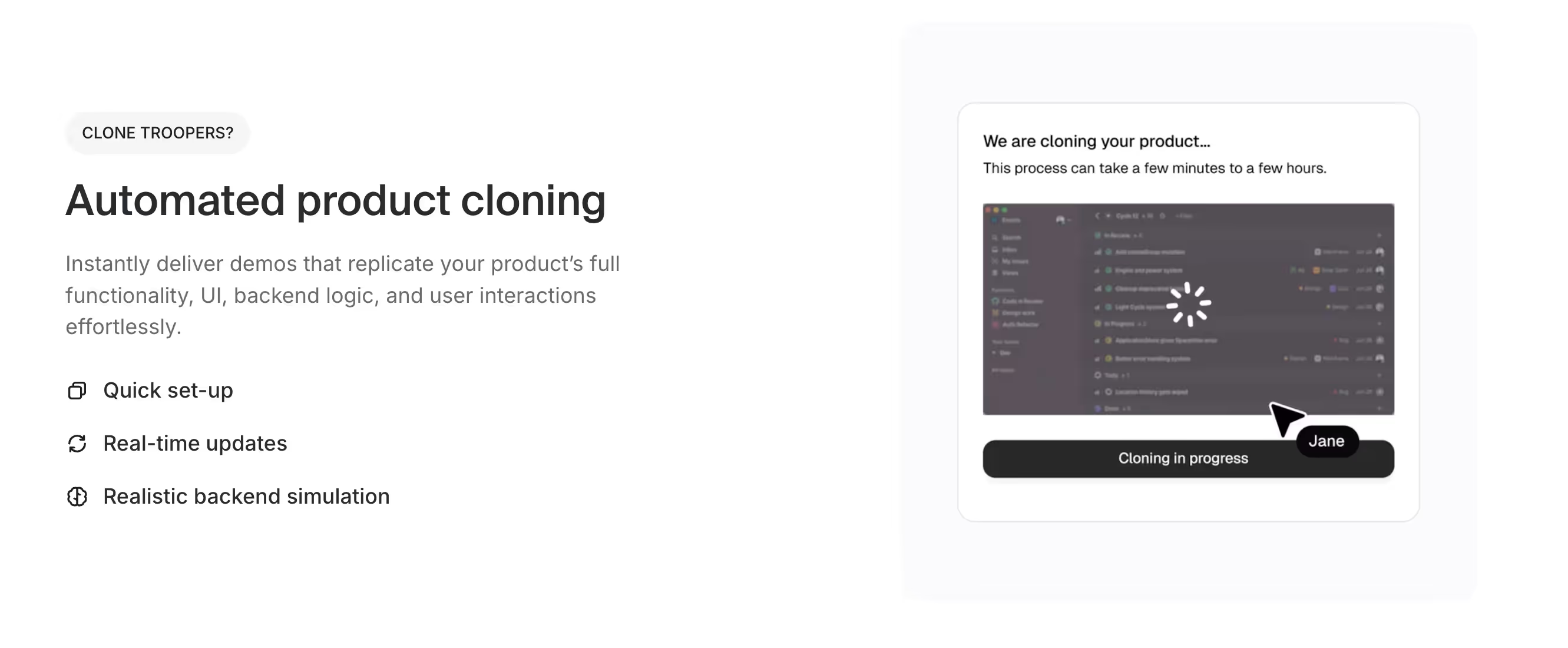
Challenge
Traditional product trials often require complex setup, data migration, and technical implementation that delays evaluation and creates barriers to prospect engagement. Many prospects want trial experiences but cannot commit resources to full implementation during evaluation phases. Static proof-of-concept presentations fail to demonstrate realistic implementation success and user adoption potential.
Solution
Live demos provide instant trial-like experiences with realistic data and workflows that demonstrate product value without implementation complexity. Prospects can simulate their business processes, test user adoption scenarios, and validate implementation feasibility through guided exploration sessions. Proof-of-concept demonstrations become interactive experiences where prospects build confidence in successful deployment and user engagement.
Benefits
- Immediate trial access without technical implementation barriers
- Enhanced proof-of-concept credibility through authentic product interaction
- Reduced prospect hesitation about implementation complexity and timeline
- 83% longer engagement sessions with live versus static demo experiences
When to use
- Prospects requesting trial access but unable to commit implementation resources
- Proof-of-concept requirements needing authentic validation without technical complexity
- Implementation feasibility concerns requiring realistic deployment simulation
- User adoption validation needing authentic workflow testing environments
Use case 5: Technical sales support and objection handling
Challenge
Technical objections often arise during sales cycles when prospects have concerns about product capabilities, performance, or integration possibilities that cannot be resolved through verbal explanations or documentation. Sales teams may lack technical depth to address sophisticated concerns while technical resources are not always available for immediate objection resolution. Unresolved technical concerns extend sales cycles and create competitive vulnerabilities.
Solution
Live demos enable immediate technical objection resolution through hands-on validation where prospects can test specific concerns directly. Technical sales support becomes interactive problem-solving sessions where prospects validate solutions to their concerns through actual product interaction. Complex technical scenarios can be demonstrated immediately without requiring technical resource scheduling or complex environment setup.
Benefits
- Immediate technical objection resolution through hands-on validation
- Enhanced technical sales support effectiveness without additional resource requirements
- Reduced competitive vulnerability from unresolved technical concerns
- Accelerated sales cycle progression through real-time concern resolution
When to use
- Technical objections requiring immediate hands-on validation
- Complex integration scenarios needing authentic compatibility demonstration
- Performance concerns requiring real-time testing and validation
- Competitive technical differentiators needing authentic demonstration
Use case 6: Multi-stakeholder deal progression with role-specific environments

Challenge
Complex B2B deals involve 8.4 stakeholders requiring product validation in average purchase decisions, each with different priorities, technical requirements, and evaluation criteria. Traditional approaches struggle to provide relevant validation experiences for decision makers evaluating strategic impact, influencers assessing team adoption potential, end users testing daily workflow efficiency, technical evaluators validating integration capabilities, budget holders analyzing cost justification, procurement teams assessing vendor reliability, and executive sponsors confirming strategic alignment.
Solution
Live demos provide customized environments for each stakeholder type with relevant data, scenarios, and functionality that address their specific evaluation needs. Decision makers can explore business impact analytics, influencers can test change management scenarios, end users can validate workflow efficiency, technical evaluators can test integration capabilities, budget holders can analyze cost-benefit scenarios, procurement teams can assess implementation requirements, and executive sponsors can validate strategic value through hands-on interaction with role-appropriate product functionality.
Benefits
- Simultaneous multi-stakeholder validation without scheduling complexity
- Role-specific product value demonstration addressing diverse evaluation criteria
- Enhanced stakeholder confidence through independent validation experiences
- Accelerated consensus building through authentic product exploration
When to use
- Complex enterprise deals involving diverse stakeholder evaluation requirements
- Consensus-building phases requiring multi-perspective product validation
- Strategic initiative evaluations needing executive sponsor engagement
- Implementation planning phases requiring technical and operational validation
How to create effective live demos in 5 steps
Building successful live demos requires strategic planning, technical implementation, and ongoing optimization to deliver authentic experiences that drive measurable business results.
Step 1: Synthetic data strategy and AI generation setup
The foundation of an effective live demo environment begins with understanding what data will best showcase your product's capabilities. Start by identifying the types, complexity, and scale of data that will create believable scenarios resonating with your target buyers. Look to your most successful customer implementations to uncover the data patterns, workflow complexity, and integration requirements that prospects expect to see in action. Collaborate closely with your sales and customer success teams to pinpoint the scenarios that most effectively communicate your value proposition and address the concerns buyers typically raise during evaluation.
Once you've mapped out these requirements, leverage AI to generate realistic, complex data sets that mirror authentic usage patterns- think emails, meetings, phone calls, project records, and complete business workflows that feel genuine rather than fabricated. Build custom templates tailored to different industries, company sizes, and use cases that align with your ideal customer profiles. The goal is to create data relationships and complexity that highlight your product's advanced capabilities while steering clear of generic examples that fail to engage or differentiate your solution from competitors.
Success metrics: Data realism scores, buyer engagement duration, scenario relevance ratings
Timeline: 2-3 weeks for initial setup, ongoing refinement based on buyer feedback
Step 2: Product API integration and data embedding
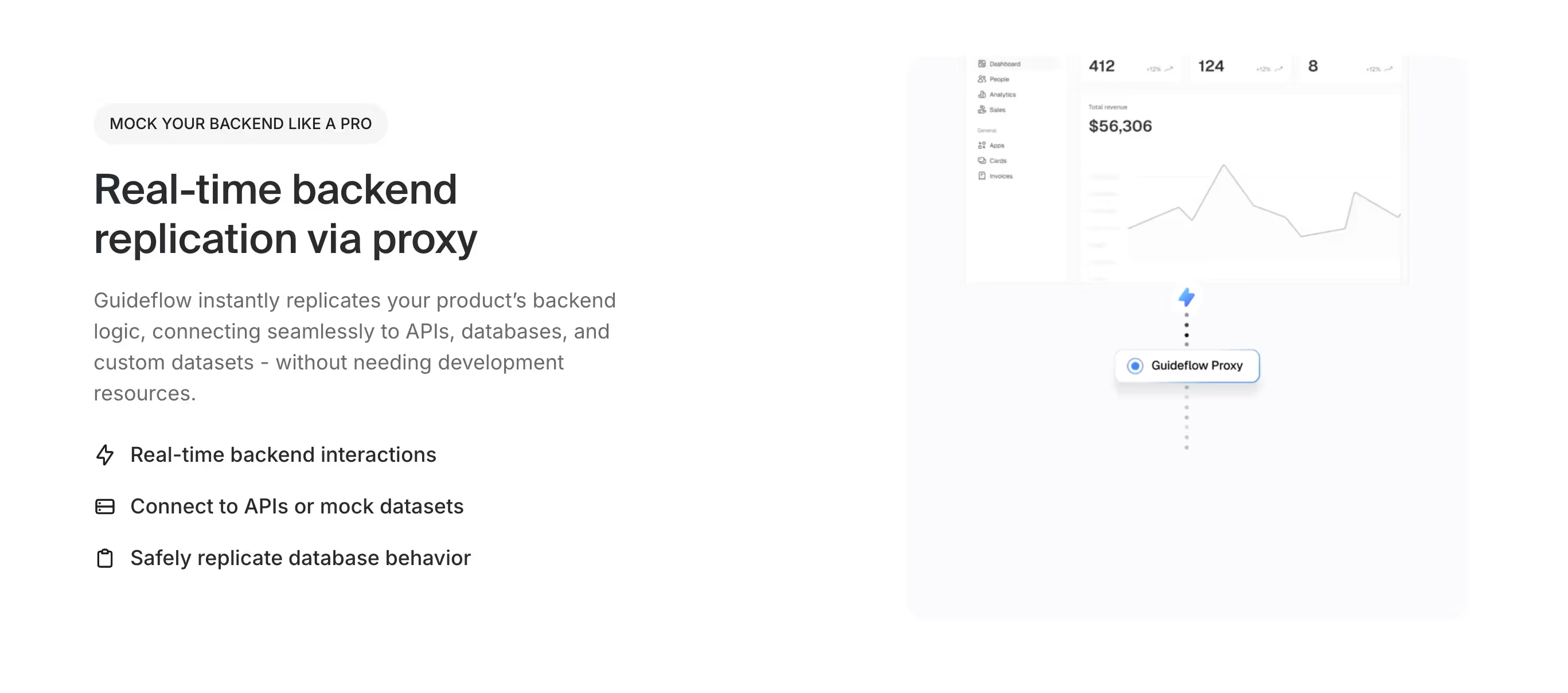
To achieve complete functionality while maintaining security, integrate synthetic data directly into live product instances using public and network APIs. This ensures that the data is embedded within the product architecture itself, rather than being superficially layered on top of interfaces. When data is properly integrated this way, all features work naturally and authentically - from AI capabilities and complex workflows to advanced functionality that buyers need to thoroughly evaluate.
Your demo environments should be configured to support the sophisticated features that differentiate your product from competitors, including machine learning, automation, integrations, and custom configurations. Throughout this setup process, ensure that data relationships and system responses accurately mirror realistic usage patterns. Finally, rigorously test all product capabilities to verify that they function authentically while maintaining strict security isolation from actual business data and production systems.
Success metrics: Feature functionality completion rates, system response times, integration validation success
Timeline: 3-4 weeks depending on product complexity and API architecture
Step 3: Activity simulation and environment maintenance

To keep live demo environments fresh and fully functional throughout extended evaluation periods, implement browser automation and scripting that maintains continuous user activity, preventing data from becoming stale. These activity plans should simulate realistic user behavior - creating data, executing workflows, interacting with systems, and utilizing features - so that environments remain responsive and ready to perform when prospects engage with them.
By configuring automated data ingestion and system updates, you can keep environments current without requiring manual intervention or ongoing technical maintenance. Complement this with monitoring and alerting systems that proactively identify and resolve functionality issues before they ever affect the buyer experience or compromise demonstration quality.
Success metrics: Environment uptime, data freshness indicators, feature functionality consistency
Timeline: 2-3 weeks for initial implementation, ongoing automated maintenance
Step 4: Seller guidance and buyer experience optimization

By developing persona-specific guidance that adapts to different buyer contexts, industries, and evaluation criteria, you maintain consistent core messaging while addressing each prospect's unique needs and priorities. These guided pathways help buyers experience key features and understand differentiation at their own pace, balancing structured navigation with the flexibility to explore based on individual interests. Throughout the experience, buyer optimization techniques like navigation assistance, feature highlighting, and contextual information work together to improve engagement and comprehension, making complex products feel accessible and compelling.
Success metrics: Demonstration consistency scores, buyer engagement completion rates, message retention indicators
Timeline: 2-3 weeks for content development and embedding
Step 5: Analytics implementation and sales acceleration
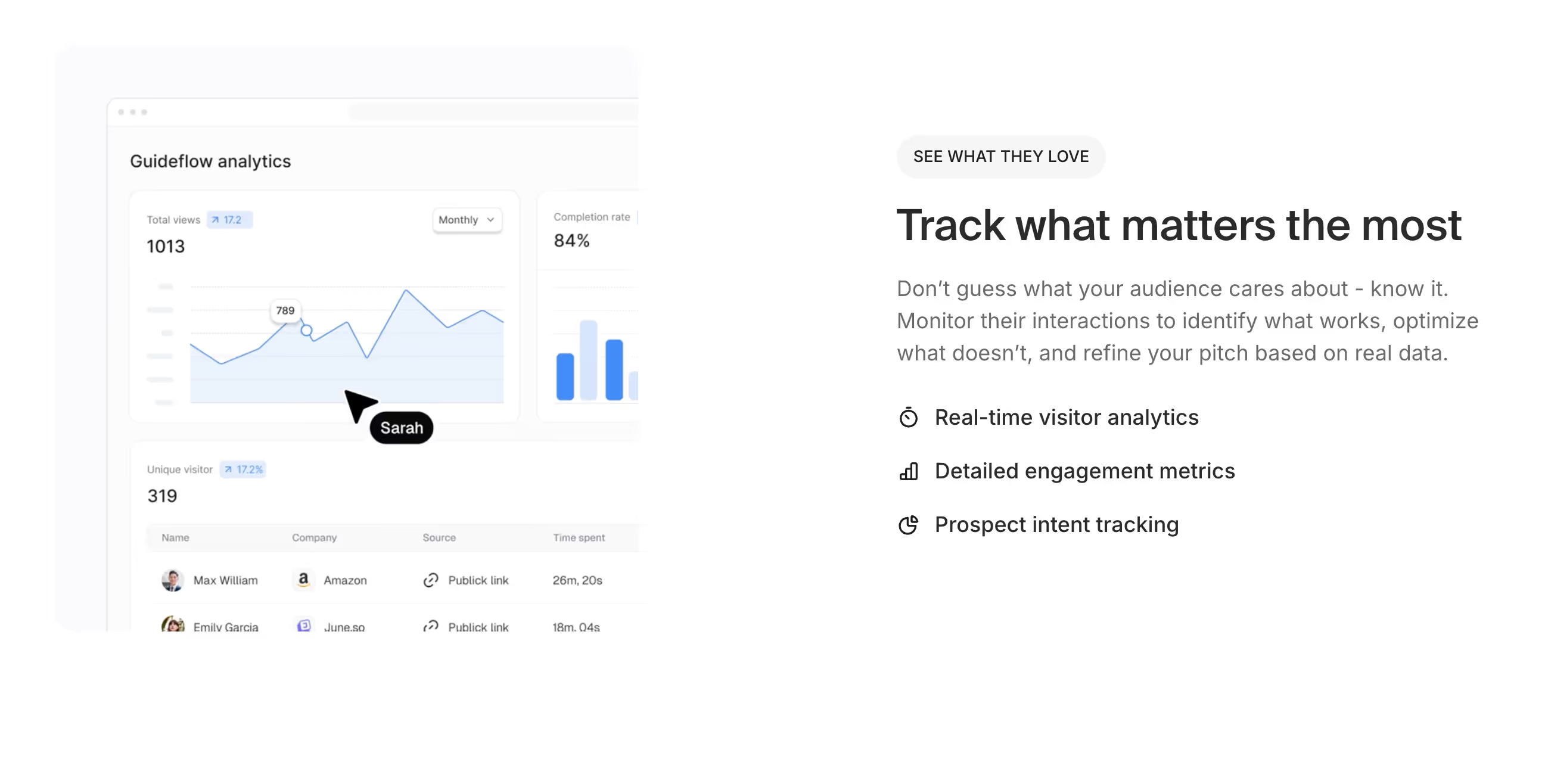
By setting up detailed tracking of feature interactions, time spent in different areas, workflow completion rates, and engagement patterns, you can reveal buyer interests and evaluation criteria in real time. This engagement data feeds into lead scoring and intent indicators that help sales teams prioritize follow-up activities and customize conversations for maximum effectiveness. When integrated with CRM and sales tools, these analytics automatically capture engagement data, trigger follow-up workflows, and provide sales teams with actionable insights that accelerate deal progression and improve conversion rates.
Success metrics: Analytics accuracy, lead scoring effectiveness, follow-up conversation quality improvement
Timeline: 1-2 weeks for implementation, ongoing optimization based on usage patterns
Conclusion
Live demos represent a fundamental shift toward authentic product experiences that address the trust and validation challenges plaguing modern B2B sales cycles. The 3.2x deal closure improvement statistic reflects the substantial impact of enabling prospects to validate product capabilities through hands-on interaction rather than passive observation of static presentations. This authenticity advantage transforms sales conversations from one-way pitches into collaborative exploration sessions that build genuine confidence and accelerate decision-making.
Rather than replacing existing sales processes, live demos enhance current approaches by providing the authentic validation experiences that prospects increasingly demand. Sales teams can integrate live demonstrations into qualification, discovery, technical evaluation, and stakeholder validation phases without disrupting established workflows or requiring extensive process modifications. The enhancement approach enables gradual adoption and iterative improvement based on prospect response and sales team feedback.
Guideflow enables sales teams to implement live demo programs through automated product cloning and real-time backend simulation that requires no development resources or technical expertise. The platform provides immediate environment provisioning, synthetic data injection, automatic resets, and behavior analytics while integrating seamlessly with existing CRM and sales enablement tools. Sales teams can begin delivering authentic product experiences that differentiate their approach and accelerate deal progression.
Ready to build more prospect trust with authentic product experiences? Start delivering live demos that provide genuine hands-on exploration, real-time validation, and authentic product interactions that accelerate deal closure, reduce technical objections, and demonstrate true product value through safe, realistic environments that prospects can explore independently.
FAQs
How do live demos build more prospect trust than traditional static demonstrations?
Live demos build trust through authentic product interaction where prospects can test edge cases, explore freely, and validate that product capabilities match sales claims. Unlike static presentations that rely on verbal assurances, live demos provide hands-on evidence of product performance, functionality, and user experience. Prospects gain confidence through direct interaction rather than passive observation, leading to stronger conviction about product value and reduced skepticism about post-purchase reality.
Can prospects break or damage anything during live demo exploration sessions?
No, live demos operate in completely isolated environments with synthetic data that reset automatically after each session. Prospects cannot access live customer data, production systems, or any information that could cause security concerns. The environments are designed for unlimited exploration without any risk to your actual product, customer data, or system stability. Each prospect receives a fresh environment that cannot impact other users or your production systems.
How do we measure authentic engagement versus surface-level interaction in live demos?
Authentic engagement measurement focuses on depth and duration of product exploration rather than simple page views or feature clicks. Key metrics include time spent testing specific workflows, number of different features explored, depth of functionality testing, and repeat session requests. Behavior analytics can identify prospects who complete realistic business scenarios versus those who browse superficially, providing qualification insights that guide follow-up strategies and resource allocation.
What happens if prospects encounter bugs or technical issues during live exploration?
Live demo environments are designed to replicate stable product functionality without exposing development builds or experimental features. However, if technical issues occur, they provide valuable opportunities to demonstrate customer support responsiveness and problem-solving capabilities. Sales teams can address issues immediately while showing prospects how technical support functions in real customer scenarios, often converting potential negatives into trust-building experiences.
How long should live demo sessions last for optimal prospect engagement?
Optimal session length varies by product complexity and prospect evaluation needs, but 83% longer engagement sessions occur with live versus static experiences. Most effective sessions range from 15-45 minutes for initial exploration, with some prospects requesting extended access for thorough evaluation. The key is allowing prospect-driven pacing rather than forcing predetermined timeframes, enabling authentic validation that builds genuine confidence.
Do live demos work for complex enterprise software with extensive customization requirements?
Yes, live demos are particularly effective for complex enterprise software because they enable authentic validation of sophisticated functionality that static presentations cannot demonstrate adequately. Enterprise prospects can test integration scenarios, validate customization possibilities, and explore advanced features through hands-on interaction. Role-specific environments address diverse stakeholder needs within enterprise buying committees, accelerating consensus building through authentic product validation.
How do live demos integrate with existing sales processes and CRM workflows?
Live demos integrate seamlessly with existing sales processes through API connections with major CRM platforms, automated activity logging, and behavior analytics that enhance prospect records. Integration enables automatic session tracking, engagement scoring, and follow-up task creation based on prospect interaction patterns. Sales teams can incorporate live demos into existing qualification, discovery, and evaluation workflows without disrupting established processes.
What training do sales teams need to facilitate effective live demo sessions?
Sales teams need training on facilitating prospect-driven exploration rather than delivering traditional presentations. Key skills include guiding discovery through product interaction, managing technical questions during live exploration, and leveraging behavior analytics for follow-up conversations. Training should address different approaches for various sales roles and prospect types, focusing on collaborative exploration rather than scripted demonstration delivery.
Can live demos be shared for asynchronous prospect evaluation and team sharing?
Yes, live demos can be shared through links that enable asynchronous exploration, allowing prospects to evaluate independently and share with team members. This capability supports modern B2B buying processes where 72% of prospects need authentic validation before sales conversations. Asynchronous access enables stakeholder evaluation without scheduling complexity while maintaining engagement tracking and behavior analytics for sales follow-up.
How do live demos handle different prospect technical skill levels and product familiarity?
Live demo environments can be customized for different technical skill levels through guided exploration paths, contextual help systems, and role-specific interfaces. Novice users can follow structured workflows while technical evaluators can explore advanced functionality independently. Adaptive interfaces and progressive disclosure ensure appropriate complexity levels for each prospect's evaluation needs and technical background.
What ROI can sales teams expect from implementing live demo programs?
Sales teams typically see 3.2x higher deal closure rates and 47% faster sales cycles through live demo implementation. Additional ROI includes improved qualification accuracy, reduced technical objection rates, enhanced stakeholder engagement, and competitive differentiation. ROI measurement should focus on pipeline progression improvement, conversion rate enhancement, and sales cycle acceleration rather than just engagement metrics.
Related posts
Learn more about Guideflow, our approach to authentication, and company news.




